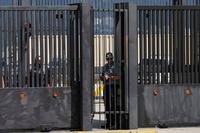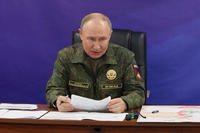ABOARD THE USS ABRAHAM LINCOLN -- On a sunbaked flight deck, Navy pilots gently taxi new, F-35C Lightning II Joint Strike Fighters forward, waiting for their turn to launch off the carrier as older, F/A-18 Super Hornets do the same.
The aviators of Strike Fighter Squadron (VFA) 125 out of Naval Air Station Lemoore, California are the first F-35C pilots in the Navy to join in carrier operations as part of the first phase of operational testing for the service's newest warplane.
"The F-35C is going out and flying with F/A-18s, E-2 [Hawkeyes], [EA-18G] Growlers and conducting the missions that they would do in combat if required," Rear Adm. Dale Horan, director of the F-35C Fleet Integration Office, told a group of reporters Monday inside the Lincoln's flight hanger, speaking above the constant din of jet engines.
"That's a big deal, because it's the first time we really see how the aircraft handles on the aircraft carrier, how we do maintenance, how we sustain it while we are at sea, and then how it integrates with the ship. How it interoperates with communications, data links, the other aircraft and then how they conduct a mission and tie into the other aircraft that are conducting that mission, and how effective they are when they do it."
The six F-35Cs arrived aboard a week ago, said Capt. Putnam Browne, commander of the Abraham Lincoln, from his perch on the bridge, overseeing flight operations.
One of the Lincoln's squadrons flew off, and "VFA-125 came in and integrated. It was basically seamless," Browne said.
The F-35C's new flight control systems "make for great landings. ... Their landings are spot on; they are above average," Browne said. "Sometimes when you change technology, you think it's going to be harder, but it actually becomes easier, and in this case I think it became easier. ... It's been amazing to see how well we can keep the deck rolling."
Navy officials painted a positive picture of the F-35C's performance in the first week of three-week, at-sea testing period but admit that many hurdles lie ahead before the aircraft achieves initial operational capability, or IOC.
"There are certainly challenges," Horan said. "We hope to see how it integrates on board ship. Can we maintain it, can we get the parts, can we get it airborne, can we repair it if it has a problem, how does it conduct its mission, what's its effectiveness?"
Horan, however, would not give specific examples of any of the test findings so far.
"This is an operational test, so I can't give the test results," he said. "I can tell you that we are out here; we operating basically per schedule and the aircraft looks like a naval aircraft out on the flight deck."
The Navy earlier had hoped to declare IOC for the F-35C this month, but program officials are now looking to meet that milestone in February, Horan said.
"We are moving in that direction, and we will get together after this and see how it went and see if things are lining up and whether we can meet that," Horan said. "If we can't, then we will make a decision and change the schedule."
For now, this is the only "at-sea period" planned for operational testing, Horan added.
"At some point, we will have to decide, 'hey, have we seen enough? Are we comfortable enough that this airplane? Is it demonstrating the capability?'" Horan said. "If so, I will make the recommendation, and the leadership will declare IOC."
The first deployment for the Navy's F-35C is scheduled for 2021. But "theoretically, as soon as we declare operational capability, if there is a contingency, I guess we could use it if we needed to," said Horan.
As a fifth-generation aircraft, the F-35 brings stealth and enhanced electronic capabilities to take U.S. airpower to the next level, program officials said. In addition to the Navy's F-35C, the joint strike fighter has two other service-specific variants: the F-35A for the Air Force and the F-35B, capable of vertical takeoff and landing, for the Marine Corps.
"I think, overall, it's an evolution in technology in warfighting capability," said Cmdr. Tommy "Bo" Locke, commander VFA 125.
"As far as just flying the aircraft ... the advanced flight control logic as well as some of the pilot control modes we use to land aboard the carrier is again evolutionary, and it has really reduced the pilot workload for us and allowed us to make more precise changes in flight path to ensure that we hit the proper wire when we come in," said Locke, who added that he prefers flying the F-35C over the older F/A-18.
"Right now, I enjoy the F-35 better; It's the newest and greatest. ... It is a dream to fly onboard and around the carrier."
-- Matthew Cox can be reached at matthew.cox@military.com.













